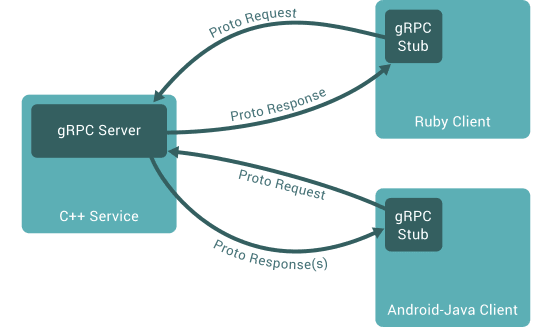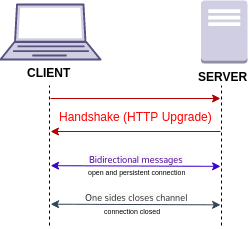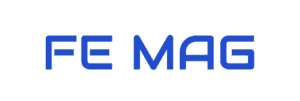As technology continues to evolve, new protocols for communication between devices and applications are constantly emerging. Two of the most popular communication protocols in use today are gRPC and WebSocket. While both protocols allow for real-time communication, they are fundamentally different in their approach and design. Understanding the differences between gRPC and WebSocket can help you choose the best protocol for your specific use case.
In this post, we’ll compare gRPC vs WebSocket, uncovering their differences in terms of protocol, transport layer, data exchange format, performance, scalability, security, and use cases. We’ll also explore how gRPC and WebSocket can be used together, as well as the future of these protocols. By the end of this post, you’ll have a clear understanding of the strengths and weaknesses of each protocol and be better equipped to choose the right one for your needs.
What is gRPC?
gRPC is an open-source remote procedure call (RPC) framework created by Google. It allows for efficient and fast communication between applications and devices across different platforms and programming languages. With gRPC, you can define the services and methods available to clients using the Protocol Buffers language. This strongly typed contract ensures that the client and server share a common understanding of the data being exchanged.
gRPC was designed to be a modern and lightweight alternative to other RPC frameworks such as SOAP and XML-RPC. It uses the HTTP/2 protocol as the transport layer and supports multiple encoding formats for data exchange, including Protocol Buffers, JSON, and XML.
One of the key benefits of gRPC is its ability to generate code automatically for a variety of languages, including Java, C++, Python, Ruby, Node.js, and more. This makes it easy for you to start using gRPC in your projects, regardless of your programming language of choice.
Overall, gRPC provides a fast, efficient, and interoperable way to communicate between services and applications, making it a popular choice for microservices architecture and other distributed systems.
How gRPC Works
gRPC is built on top of the HTTP/2 protocol, which allows for the bidirectional streaming of data between the client and server. Both the client and server can send multiple requests and responses at the same time, making communication more efficient.

To use gRPC, you first define the services and methods available to clients using the Protocol Buffers language. This generates client and server stubs in the desired programming languages, which can then be used to implement the desired functionality.
When a gRPC client makes a request to the server, it first establishes a connection over HTTP/2. The client then sends a request message to the server, which is encoded using the agreed-upon data exchange format (such as Protocol Buffers).
The server receives the request message and decodes it before executing the requested method. The server then sends a response message back to the client, which is also encoded using the agreed-upon data exchange format.
gRPC supports several types of method invocation, including unary, server streaming, client streaming, and bidirectional streaming. Unary methods are the simplest, where the client sends a single request and the server sends a single response. Streaming methods, on the other hand, allow for the continuous exchange of data between the client and server.
Advantages of gRPC
gRPC offers several advantages over other RPC frameworks, including:
- High performance: gRPC uses HTTP/2 and efficient binary encoding formats like Protocol Buffers, which make it faster and more efficient than other RPC frameworks.
- Interoperability: gRPC supports multiple programming languages and platforms, making it easy for you to use it in a variety of projects.
- Code generation: gRPC generates client and server stubs automatically for several programming languages, reducing the amount of boilerplate code that you need to write.
- Streaming: gRPC supports streaming, which allows for the continuous exchange of data between the client and server, making it ideal for real-time applications.
- Strong typing: gRPC uses Protocol Buffers for defining services and methods, which ensures that the client and server share a common understanding of the data being exchanged.
- Scalability: gRPC is designed to be highly scalable, allowing for the easy deployment of microservices and other distributed systems.
Disadvantages of gRPC
While gRPC offers several advantages, there are also some potential drawbacks to consider:
- Complexity: gRPC can be more complex to set up and use than other RPC frameworks due to its reliance on Protocol Buffers and HTTP/2.
- Learning curve: If you are not familiar with Protocol Buffers and HTTP/2, you may need to invest time in learning these technologies before using gRPC effectively.
- Limited browser support: gRPC’s reliance on HTTP/2 means that it may not be compatible with all browsers and platforms.
- Debugging: Debugging gRPC can be more difficult than debugging other RPC frameworks due to its use of binary encoding formats.
- Deployment: gRPC may require additional infrastructure and configuration to deploy effectively, especially in large-scale distributed systems.
What is WebSocket?
WebSocket is a protocol that enables real-time, bidirectional communication between a client and a server over a single, long-lived connection. Unlike HTTP, which is a request-response protocol, WebSocket allows for continuous data exchange between the client and server.
WebSocket was developed as a solution to the limitations of HTTP for real-time web applications, which require low-latency, high-bandwidth communication between clients and servers. With WebSocket, data can be sent and received as soon as it’s available, without the need for repeated requests and responses.
How WebSocket Works
WebSocket works by establishing a persistent, bidirectional connection between a client and server over a single TCP socket. The WebSocket protocol begins with a handshake, which consists of an HTTP upgrade request from the client and an HTTP upgrade response from the server.

Once the connection is established, the client and server can exchange data in both directions without the need for repeated requests and responses. This allows for low-latency, high-bandwidth communication between the client and server.
WebSocket uses a simple message-based data exchange format, which can be used to send and receive data of any type. Messages can be sent as text or binary data and can be of any size.
Advantages of WebSocket
WebSocket offers several advantages over other communication protocols, including:
- Low latency: With WebSocket, data can be exchanged in real-time, without the need for repeated requests and responses. This allows for low-latency communication between the client and server.
- High bandwidth: WebSocket allows for the exchange of large amounts of data between the client and server, without the overhead of repeated requests and responses.
- Reduced server load: Since WebSocket allows for continuous data exchange between the client and server, it can reduce the load on the server compared to other communication protocols.
- Bi-directional communication: With WebSocket, both the client and server can send and receive data in real time, allowing for bi-directional communication.
- Widely supported: WebSocket is widely supported by modern web browsers and can be used with a variety of server-side programming languages and platforms.
Disadvantages of WebSocket
While WebSocket offers several advantages, it also has some limitations and disadvantages, including:
- Complexity: WebSocket requires a more complex implementation compared to other communication protocols, which can make it more difficult to set up and maintain.
- Security: WebSocket is vulnerable to certain types of security attacks, such as cross-site scripting (XSS) and cross-site request forgery (CSRF). However, these can be mitigated with appropriate security measures.
- Firewalls and proxies: WebSocket can be blocked by some firewalls and proxies, which can limit its usability in certain environments.
- Limited use cases: WebSocket is primarily designed for real-time web applications and may not be the best choice for other types of applications that do not require low-latency communication.
Comparing gRPC vs WebSocket
The following table summarizes the key differences between gRPC and WebSocket:
| Feature | gRPC | WebSocket |
|---|---|---|
| Protocol | Uses a binary protocol buffer format | Uses text-based messaging protocol |
| Transport layer | Uses HTTP/2, which is multiplexed, reliable and secure | Uses TCP or WebSocket protocol |
| Data exchange format | Uses Protocol Buffers, which is fast and efficient for small to medium-sized messages | Uses JSON, which is human-readable and suitable for larger messages |
| Performance | gRPC is faster and more efficient due to binary data format and HTTP/2 multiplexing | WebSocket is slower due to its text-based format and lack of HTTP/2 features |
| Scalability | gRPC can handle large traffic volumes and has built-in load-balancing features | WebSocket can handle moderate traffic but may require additional load-balancing tools |
| Security | gRPC uses Transport Layer Security (TLS) encryption by default and has built-in authentication features | WebSocket can use TLS encryption but lacks built-in authentication features |
| Use case | Ideal for microservices architectures and real-time data streaming applications | Ideal for real-time data streaming applications and web applications |
In the subsequent sections, we will provide a thorough comparison of each factor.
Protocol
One of the key differences between gRPC and WebSocket is the protocol used for communication.
gRPC uses the Remote Procedure Call (RPC) protocol, which allows the client to invoke methods on the server as if they were local functions. The gRPC protocol supports both unary and streaming communication, allowing for efficient and flexible data exchange.
WebSocket, on the other hand, uses a different protocol called the WebSocket protocol. This protocol is designed for bi-directional communication between the client and server and allows for real-time data exchange without the overhead of repeated requests and responses.
Transport Layer
Another key difference between gRPC and WebSocket is the transport layer used for communication.
gRPC uses the HTTP/2 protocol for transport, which allows for efficient and multiplexed communication between clients and servers. HTTP/2 supports server push, meaning that the server can push data to the client without the client requesting it, which can significantly improve performance.
WebSocket, on the other hand, uses the WebSocket protocol for transport, which is built on top of the HTTP protocol. WebSocket allows for low-latency communication between clients and servers, with a persistent connection that remains open for the duration of the communication session.
Data Exchange Format
In addition to the protocol and transport layer used for communication, gRPC and WebSocket also differ in the data exchange format.
gRPC uses Protocol Buffers as its default data exchange format. Protocol Buffers is a language-agnostic, efficient, and extensible serialization format that is well-suited for building distributed systems. Protocol Buffers offers a compact binary representation of data and supports schema evolution, which allows for forward and backward compatibility between different versions of the same data model.
WebSocket, on the other hand, uses JavaScript Object Notation (JSON) as its default data exchange format. JSON is a lightweight and human-readable data interchange format that is widely supported by web browsers and programming languages. JSON is easy to work with and provides a flexible and extensible way to represent data.
Performance
Both gRPC and WebSocket offer high-performance communication between distributed systems, but they differ in their approach.
gRPC uses binary serialization and a highly efficient binary protocol, which makes it a high-performance option for building distributed systems. Protocol Buffers offer a compact binary representation of data, reducing the amount of data transmitted over the network and resulting in lower network latency and higher throughput.
WebSocket, on the other hand, uses a text-based protocol and JSON data exchange format, which can result in higher network overhead compared to gRPC. However, WebSocket offers low latency and high throughput for real-time web applications.
Scalability
Scalability is an essential factor for distributed systems that need to handle a large number of clients and requests. Both gRPC and WebSocket offer good scalability features, but they differ in their approach.
gRPC uses HTTP/2 as the underlying transport protocol, which provides support for multiplexing, flow control, and server push. These features enable gRPC servers to handle multiple requests concurrently and efficiently use network resources. Additionally, gRPC supports load balancing and service discovery, which makes it easy to scale applications horizontally.
WebSocket also supports scaling horizontally by implementing load balancing and service discovery. However, unlike gRPC, WebSocket does not offer native support for multiplexing, which can result in increased network overhead for handling multiple requests concurrently.
Both gRPC and WebSocket offer good scalability features, but gRPC may be a better choice for applications that require efficient handling of multiple concurrent requests.
Security
Security is a crucial aspect of any communication protocol, especially for distributed systems that operate over the internet. Both gRPC and WebSocket offer secure communication, but they have different security features.
gRPC uses Transport Layer Security (TLS) for secure communication between clients and servers. TLS provides end-to-end encryption, server authentication, and data integrity to ensure that the data exchanged between clients and servers cannot be intercepted or modified by third parties. Additionally, gRPC supports mutual authentication, where clients and servers authenticate each other to establish trust.
WebSocket also supports secure communication using TLS, but it does not provide mutual authentication by default. However, WebSocket allows for custom security implementations that can enable mutual authentication and other security features.
In general, both gRPC and WebSocket offer secure communication, but gRPC provides more out-of-the-box security features, including mutual authentication, making it a better choice for applications that require strong security.
Use Cases
Both gRPC and WebSocket have their strengths and weaknesses, and their suitability for a given use case depends on several factors, such as the nature of the application, the type of data being exchanged, and the performance and security requirements.
gRPC is a good choice for applications that require fast and efficient communication between clients and servers, especially when dealing with large amounts of data. It is well-suited for microservices architecture, where several small services need to communicate with each other in a distributed environment. gRPC’s support for multiple programming languages also makes it ideal for polyglot architectures, where services are written in different programming languages.
WebSocket, on the other hand, is a good choice for applications that require real-time communication, such as chat applications, online gaming, and stock trading platforms. It is also a good choice for applications that require bidirectional communication, where clients and servers need to exchange data in both directions.
How gRPC and WebSocket Can Be Used Together
One interesting aspect to consider is how gRPC and WebSocket can be used together in a complementary way. gRPC can be used for server-to-server communication, while WebSocket is ideal for client-to-server communication, especially in real-time web applications.
For example, imagine a chat application that requires real-time communication between the server and the client. WebSocket can be used to establish a persistent connection between the client and server, while gRPC can be used to facilitate server-to-server communication for authentication and other back-end functions.
Another use case could be a streaming service that requires real-time updates for the user’s watch history, playlist updates, and more. WebSocket can be used to push real-time updates to the client while gRPC can be used to facilitate server-to-server communication for video encoding, thumbnail generation, and other backend functions.
By combining the strengths of both technologies, you can create more robust and efficient applications that meet the needs of your users.
Future of gRPC and WebSocket
The future of gRPC and WebSocket looks bright, as both technologies continue to evolve and improve.
For gRPC, the release of gRPC-web has opened up new possibilities for using gRPC in the browser. This allows for more efficient communication between the front-end and back-end of web applications. Additionally, gRPC is being used more widely in microservices architectures due to its efficiency and flexibility.
As for WebSocket, it continues to be a popular choice for real-time web applications and has been widely adopted by major tech companies. WebSocket also supports new protocols like HTTP/3, which allows for faster and more reliable communication over the internet.
Looking ahead, it’s likely that gRPC and WebSocket will continue to be used in tandem in many applications, as they offer complementary strengths for different types of communication. As the demand for real-time and efficient communication grows, we can expect to see continued development and innovation in both gRPC and WebSocket.
Conclusion
In conclusion, both gRPC and WebSocket have their unique features and use cases. gRPC is a modern and high-performance RPC framework suitable for microservices architecture, while WebSocket is a protocol for two-way communication between a client and a server over a single TCP connection, suitable for real-time web applications.
gRPC and WebSocket can be used together to create powerful and efficient applications that require both high-performance and real-time communication. For example, a microservices-based application can use gRPC for inter-service communication and WebSocket for real-time communication between the client and the server.
The future of gRPC and WebSocket is promising, as more developers and organizations are adopting microservices architecture and real-time web applications. With the continuous development and improvement of these technologies, we can expect even more efficient and scalable applications in the future.
In summary, understanding the differences and similarities between gRPC and WebSocket is crucial for selecting the appropriate technology for your application. By considering the protocol, transport layer, data exchange format, performance, scalability, security, and use case, you can make an informed decision that meets your application’s requirements.
FAQs
Q: Which one is faster, gRPC or WebSocket?
A: It depends on the use case and the specific implementation. In general, gRPC is faster for small payloads and synchronous communication, while WebSocket is better for larger payloads and asynchronous communication.
Q: Is gRPC secure?
A: Yes, gRPC provides built-in support for Transport Layer Security (TLS) encryption and authentication.
Q: Can I use WebSocket with any programming language?
A: Yes, WebSocket is supported by many programming languages and frameworks, including JavaScript, Java, Python, and more.
Q: What are some popular use cases for gRPC and WebSocket?
A: gRPC is commonly used for microservices architecture, while WebSocket is often used for real-time communication and chat applications.
Q: Can gRPC and WebSocket be used together?
A: Yes, it is possible to use gRPC and WebSocket together in the same application. For example, you could use gRPC for backend microservices and WebSocket for real-time communication between clients and the server.
Q: Are there any drawbacks to using gRPC or WebSocket?
A: Both technologies have their own advantages and disadvantages, and the choice depends on the specific requirements of the application. For example, gRPC may not be as widely supported as REST APIs, while WebSocket may not be suitable for many types of applications.

